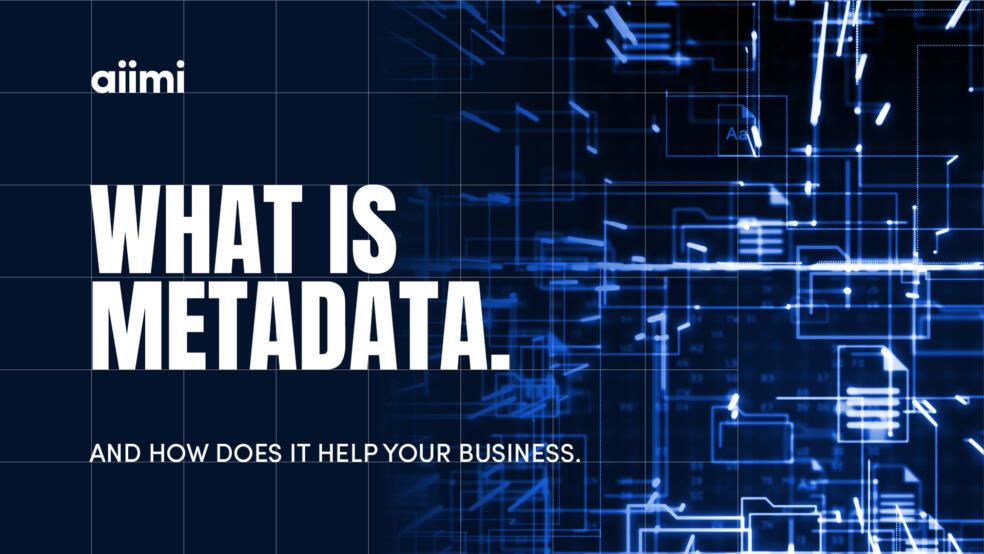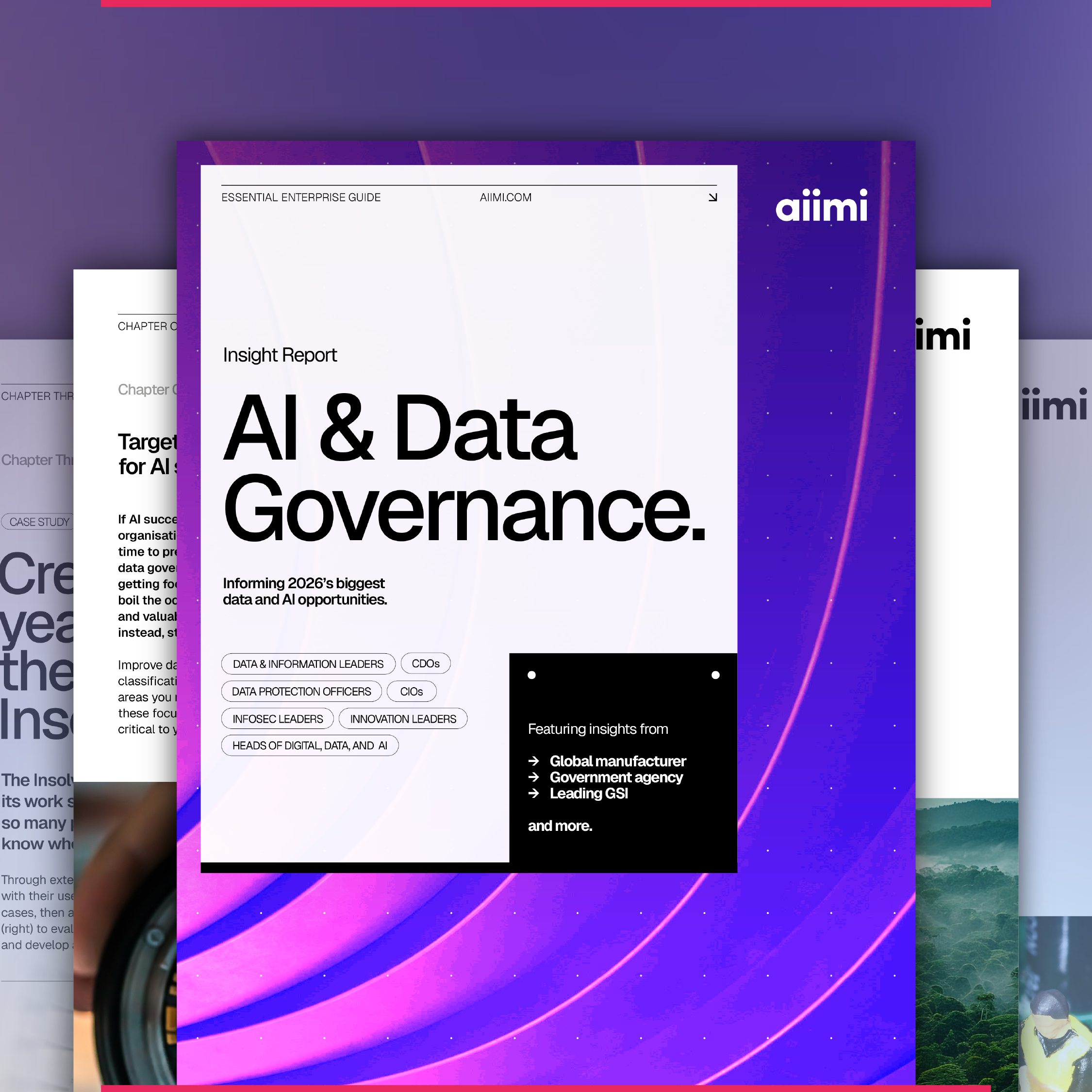What is metadata, and how does it help your business?

In this blog we’ll unpack what metadata is and how it brings value to your business.
So, what is metadata?
It’s data that describes data. We use it to group, categorise, and add context to data.
Different companies and software vendors may call metadata by other names, like tags, entities, or classifications. None of these terms are wrong, but at Aiimi, we refer to metadata as labels.
These labels are intelligent; they’re part of a complex process that needs the right Machine Learning techniques and AI tools to pull out vital data from within hundreds of documents and group them into 2 or 3 buckets of content, creating thousands of new labels and associations. It’s not the kind of labelling process a human could manually do; the scale and complexity of information found within vast numbers of documents require data-driven tools.
When we start to apply labels across an enterprise, they can help you find out more about what you have, how and where the information is stored, and what processes are in place. Having information labelled helps you look after it in the right way; it gives the right people access to knowledge that helps them do their job.
What are the different types of metadata?
One of Aiimi’s key differentiators is our Insight Engine’s ability to handle structured and unstructured data the same. And we talk about them using the same terms, too: whether we’re referring to structured or unstructured data, we call both pieces of content ‘records’. There are three types of labels we can apply to these records:
Labels that sit around the record
Labels within the record
Labels that derive from the record
Let’s see them in practice.
Labels that sit around the record
For example, in a Word document the labels around this record are labels like who created the record, the date it was created, and where it’s stored. Those are the standard kind of metadata labels.
Labels within the record
When we open the Word document, we can start to pull out interesting things that exist within the record, such as phrases, topics, or specific dates we want to label. We pull out things that might be interesting within the Word document, enabling it to be used in different contexts, with the right labels providing useful insight.
Different Machine Learning techniques can be used to capture labels within the record. We use Named Entity Recognition (NER) to identify the names of people, organisations, and locations. Dictionary Lists curate lists of information that matches the data found.
We use Regular Expressions (RegEx) to find information that can form standardised patterns, like driving licence numbers, account numbers, phone numbers, and email addresses. We use Machine Learning algorithms to pick out predefined lists of phrases and topics, to classify the information and enable us to view it in new ways.
Labels that derive from the record
We also classify the record by stating what it is based on its content. We use an automated process to generate labels related to a specific record classification. If the record was a ‘Statement of Work’, the software would automatically crawl through, label relevant information (scope of work, etc.), connect it all together, and classify the record as a ‘Statement of Work’.
We can use the same automated process to identify commercially sensitive materials (limiting the number of people who view the content), assigning security levels using a risk score.
Statistical analysis is used to cluster records that look the same by recognising where they are similar and labelling new/existing records with the same label, like purchase orders and invoices.
What value can metadata (automatic labelling) bring to your business?
Metadata can:
1) Increase the value of data to the user.
Connecting everything you have helps you locate data, use it, and determine if the information presented is valuable, enabling you to answer questions, make data-driven decisions, and do your job better.
2) Add context to the information in a consistent way.
It can expose challenges you’re not aware of, drive business opportunities forward, and enable your users to work more efficiently and effectively.
3) Improve your access to information.
With the right information, teams across your enterprise can effectively manage their data and use it to do their jobs better, rather than working in silos. Through automatic labelling, enrichment, and classification processes, your enterprise can work collaboratively and better share knowledge.
4) Comply with laws and regulations and protect your business.
Labels are tools that enable control, so you can identify risks, maintain intellectual property, and facilitate compliance. Applying the right labels automatically across your enterprise keeps you compliant in a complicated regulatory environment. Machine Learning capabilities are trained to the latest regulations, laws, governance policies, data protection acts, and security standards, so you’re able to assign risk levels and lock down or move information accordingly, pinpointing data that needs protecting.
5) Empower your senior leadership team.
The right labels give your leadership team the confidence they need to make critical business decisions that are data-driven and evidence-based.
6) Instil confidence in stakeholders.
Employees, partners, customers, suppliers, and investors can be assured you’re handling their and enterprise data correctly, protecting their interests.
How does metadata (automatic labelling) help your business?
Labels organise your enterprise data in a consistent way that is meaningful to everyone across your business, making it easier to locate the right information first time. Here are five real-world examples of how metadata can add value to your business.
Inbound customer communications
As a Customer Success Manager, having the right set of labels applied to your customer communications can help quickly classify and prioritise responses, push work to the right people to process the enquiry faster, and deliver a better end-user experience for your customers. The labels for each customer communication tell us what they’re talking about, to whom, and how often they’ve been in touch with the Customer Success team.
With this information, Customer Success Managers can quickly discover what’s going wrong, which processes need attention, and how to improve their customer satisfaction strategy, with specific metrics to keep on track.
Intellectual property
Let’s say you invested £100m in the research and development of a brand-new car. The designs and latest innovations are your intellectual property, and you don’t want your competitors to get their hands on them. Without labelling and classifying the records, it’s hard to control who has access to the records, leaving them exposed to risk.
When you apply labels to your records, you’re able to manage the visibility of your intellectual property across your business, so you can control who can find it, access it, and use it. This mitigates risk and protects valuable information.
Sensitive data
Imagine you’re a Data Protection Officer who is struggling to fulfil large volumes of DSARs and needs to comply with external regulations like GDPR, on top of internal compliance processes. It’s a time-consuming, resource-heavy challenge. When records containing personal data aren’t labelled correctly, you’re exposed to security breaches, fines, personal data loss, poor customer experience, and complaints.
But if you apply the right labels to your data subject’s personal data, you can mitigate risk and demonstrate to the ICO and your customers that you’re looking after their data the right way. You’re able to locate information quickly, stay compliant, know who’s responded to the request, share information across teams, and deliver a seamless experience to your customer and employee data subjects.
Export control
Let’s say you work for a government department with an international remit and you’re in charge of handling large volumes of documents. Inside those documents are certain processes, products, or assets that you know can’t be shared with other countries. Through automatic labelling, specific regulation tags can be used to pull out information relating to those processes, products, and assets.
With the documents labelled, you can classify information the right way – using AI to quickly identify which data is regulated, which can be shared, and which needs to be kept hidden. It’s an effective solution for keeping you compliant at speed and at scale, to label, classify, identify, and group codified volumes of regulated information.
Security classification
In a digital-first world where data is at the heart of business, Chief Information Security Officers need to adapt to ever-evolving security needs and requirements that come with increased demand for access to information. With automatic labelling and enrichment, you’re able to classify and secure your data through risk ratings, sensitivity levels, access controls, and classification, to detect potential threats and deploy cybersecurity solutions to protect sensitive information.
Automatic labelling with The Aiimi Insight Engine
The Aiimi Insight Engine enriches all information across the enterprise through automatic labelling, using our AI-powered platform and Machine Learning techniques to turn data into knowledge and insights. It makes understanding your data universe simple by discovering, enriching, and interconnecting everything, no matter where it lives, so you can access its hidden value.
Explore more practical advice, success stories, and expert insights. Visit the Aiimi CIO+ Hub.
Stay in the know with updates, articles, and events from Aiimi.
Discover more from Aiimi - we’ll keep you updated with our latest thought leadership, product news, and research reports, direct to your inbox.
You may unsubscribe from these communications at any time. For information about our commitment to protecting your information, please review our Privacy Policy.



